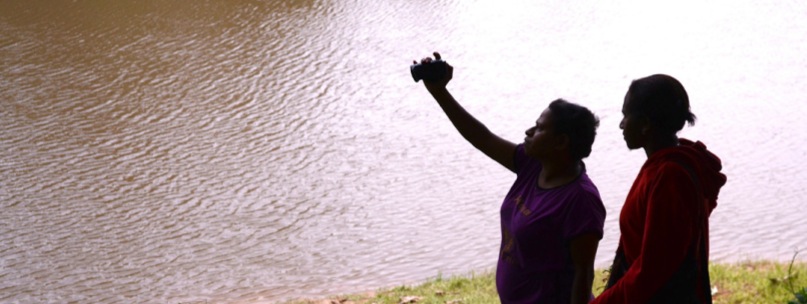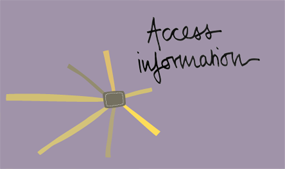
From monitoring elections to recording police brutality, we as citizens are now equipped with all kinds of digital tools which enable us to collect and share information exposing wrongdoing and demanding transparency.
Why use it?
Collecting information in a concise and targeted way provides you with materials to base your work on. This can give your organisation credibility, and provide you with a running archive of your work.
Implicit in the act of documenting is the act of monitoring – of recording for posterity and accountability. Producing your own content puts the power of media creation and information control back in the hands of you and your community.
You can collect or document information by:
- doing surveys within your constituency or target audience
- using a digital recording device – eg. camera, video camera, audio recorder
- searching for existing data or content online
- making a request for data from the relevant public or government office
- creating an interactive platform inviting people to submit their own information (see our chapter on engaging communities in participatory projects and crowdsourcing)
How can I use it for my campaign?
To craft a good story, you must have good content. To design a great infographic, you must have good data. The quality of your raw materials is crucial.
Collecting data online
- Services like Surveymonkey or Ushahidi allow you to publish or present information in complex ways.
- Crowdsourcing, or outsourcing some information collection to your constituents, can also be an effective way of collecting data.
- Magpi is a tool that allows you to create and collect information through mobile phone surveys.
Curating content
- Curating content, or manually pulling together content from blogs, twitter feeds, or videos, is another good way to collect data.
- See this list of content curation tools from Emergency Journalism.
Your right to access public information

Public bodies operate with public money. Their role is to serve members of the public and the information they create and hold belongs to the public. National and international law recognises that members of the public have a fundamental right of access to information from public bodies.
Even if your country doesn’t have an ‘access to information’ law (called ‘Freedom of Information Act’ or ‘Right to Information Act’ in some countries), there are likely to be some provisions which require public officials to answer requests from the public. Go here for a full list of countries with access to information laws.
The right of access to information operates in two ways:
- Proactive: public bodies are required to provide, publish and disseminate information about their main activities, budgets and policies.
- Reactive: all people have the right to ask public officials and bodies for information about what they are doing and what documents they hold.
Read more: 3 steps to making an information request
Visit Tactical Tech's own Visualising Advocacy site for an in-depth look at some of the tools and techniques of data collection for advocacy work.
Recording media
Documenting through multimedia is the first step towards creating a pool of content on which to base your campaign or project. The more focused your approach, the clearer your vision of the end result will be – and that means less work, and less wasted time later.
Documenting can be a political act in itself, but your content will have greater impact if you share or develop it. Think about what the content could be used for:
- for an archive or a searchable database
- for posterity / monitoring purposes (see our chapter on documenting on the go)
- as source material for a digital story (see our chapter on digital storytelling)
How you document, and what format you use, will vary depending on what you want to achieve. In almost all cases, however, it is crucial to accurately log the time and date.
For an archive or database, your content will need to be searchable - ie you'll need a system that enables you to analyse the content in terms of keywords, and split it into manageable chunks.
*Sites like Soundcloud allow you to tag audio content with keywords.
*Photo sites like Flickr allow you to search for images based on user-generated keywords.
When recording video for a story, consider the kind of story you want to tell, plus the tone and length, and plan accordingly. For fictionalised stories, you can storyboard your shots - ie, outline them in sketches on paper beforehand.
For documentaries, the tendency is to document as much as you can - long-form interviews, contextual shots, action footage - and cut the footage down in the editing room to let a story emerge. There is no one right way or wrong way to go about documenting your reality; but there are a few few guidelines you can follow to make things easier.
Some tips to remember when recording media
- Practical Tips for Video - Recording, converting, editing and distributing your video
- Practical Tips for taking photos
- Practical Tips for Audio - Recording audio; recording audio for video or with a mobile phone; converting and editing your audio
Case Studies
India: Collecting government data in Chennai
In Chennai, India, the Transparent Chennai website aggregates data from government and independent sources to help community workers identify the areas in Chennai most in need of basic services. Official data is often contradicted by crowdsourced data, which shows the reality on the ground.
Videotaping police beating: Rodney King
In 1991, a bystander videotaped the Los Angeles Police Department's brutal beating of a young man called Rodney King. The video was seen by millions of people around the world and used as evidence in a court case against the police officers concerned. It also inspired the creation of WITNESS, an organisation aimed at empowering citizens to use video for human rights.
Protesting Chinese surveillance
More recently, in 2012, Chinese political artist Ai Wei Wei set up a simple system of home webcams, he was able to broadcast his life under house arrest to the public, thereby cleverly inverting the government's own surveillance of him. When anyone could monitor him day and night, the need for surveillance was rendered redundant.
Documenting the West Papua/ Indonesia conflict from the ground
Despite continuing clashes over the last 40 years, the ongoing conflict between West Papua and Indonesia remains largely unknown to the public. Press freedom in West Papua is low.
In 2011-12, a group of Papuan activists documented the stories of daily life in West Papua: the struggle for equality and dignity, better access to education and environmental protection. Their videos were published on the Papuan Voices website, along with Study and Screening guides, designed for use in classrooms and community contexts, which helped the videos receive international visibility.
Morocco: Documenting police officers accepting bribes
In 2007 and 2008, the Targuist Sniper captured and posted videos on Youtube showing police officers in Morocco accepting bribes from drivers on the road. His videos were viewed over 1.7 million times, prompting the Moroccan government to enforce large-scale fines on his town in an attempt to pressure him to stop his activities.
Egypt: Documenting the 2011 uprisings
IamJan25.com is an online collection of images and videos captured during the Egyptian uprising. It stands as a powerful record of unfiltered eye-witness accounts captured by demonstrators themselves.
India: monitoring bribe-taking
Indian NGO Janaagraha, based in Bangalore, created 'I Paid A Bribe' to foster a culture of whistleblowing in India. The website allows people to anonymously report their stories (written or recorded on video) of instances where they have either had to pay a bribe, or declined to pay a bribe when asked. The data is then analysed, revealing which government departments are the most corrupt.
UK: collecting government data
The website TheyWorkForYou was created by MySociety to aggregate content from various UK parliamentary records and other data, such as the election records of MPs, which is publicly available. The site allows UK citizens to connect with the Members of Parliament in their country, read debates, and monitor what their local representative is doing in their name.
Burma: monitoring elections
The Alternative Asean Network on Burma's (ALTSEAN-Burma) 2010 election watch created a no-frills website to provide background information, analysis, and up-to-date information on the 2010 Burma elections, and to monitor the election process itself. The format was concise and user-friendly, for activists, media, researchers, legislators and policy-makers.
EU: Govt farm subsidies -- following the money
Farmsubsidy.org uses Freedom of Information Act requests to compile information on farm subsidy funds from government sources in every EU member state. They make this data publicly available, allowing citizens to create their own lists and investigate where the money went.
Slovakia: tracking government spending
An initiative in Slovakia, called Fair Play, gathers invoices and other documents that show how the Slovakian government spends its money. This material is then added to a database connected to the Fair Play website, and people are invited to use this information to influence political change.
Additional resources:
- Go to Tactical Tech's message-in-a-box filming and editing section for more tips on shooting, audio, lighting, editing and more.
- Witness, a US-based NGO promoting the use of video for human rights advocacy, has a great set of resources around Documenting and Reporting with video. Have a look at their PDF on Filming for Human Rights Documentation, Evidence and Media.
- The Center for Social Impact Communication has produced a guide called Communicating via imagery, which provides a framework for non-profit organisations who want to use photography as a central element of their communications strategy.
- The Creative Activism website has a good module on Documentary and Video for Change, with a lot of examples.
- Digital Democracy has published a digital media training manual on basic concepts of framing and composition for photo and video.